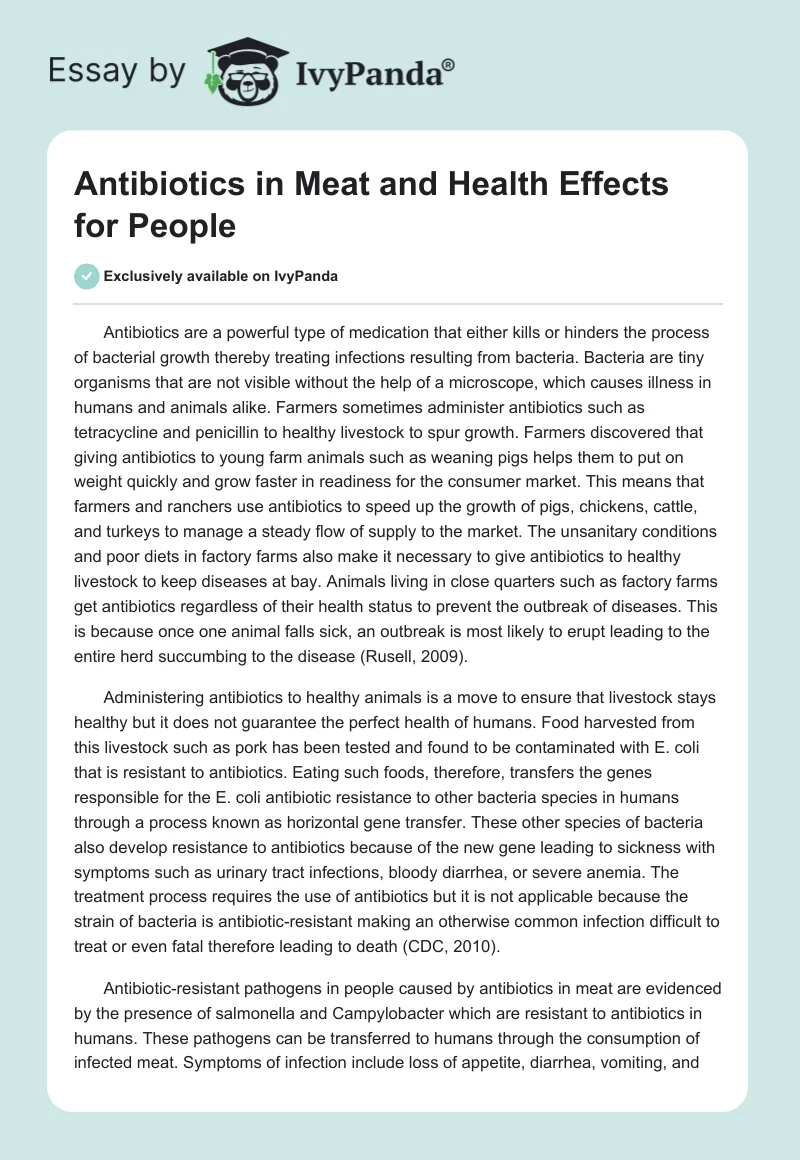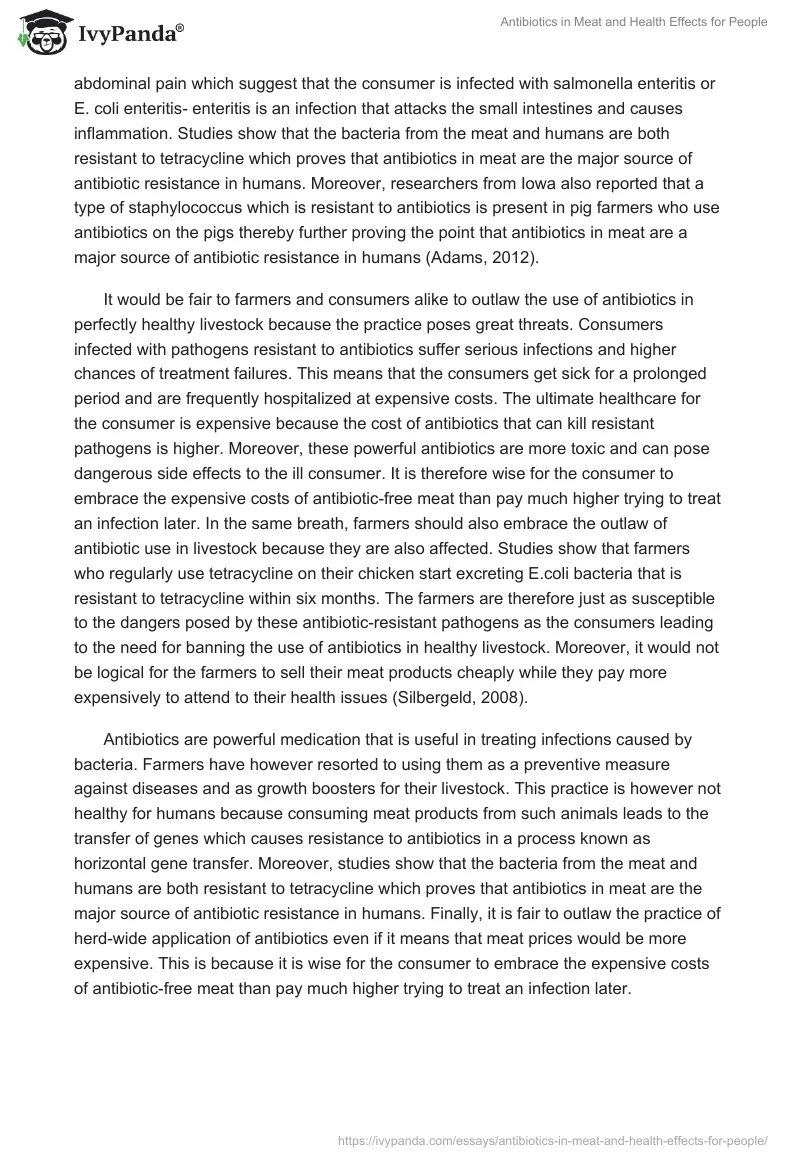Antibiotics are a powerful type of medication that either kills or hinders the process of bacterial growth thereby treating infections resulting from bacteria. Bacteria are tiny organisms that are not visible without the help of a microscope, which causes illness in humans and animals alike. Farmers sometimes administer antibiotics such as tetracycline and penicillin to healthy livestock to spur growth. Farmers discovered that giving antibiotics to young farm animals such as weaning pigs helps them to put on weight quickly and grow faster in readiness for the consumer market. This means that farmers and ranchers use antibiotics to speed up the growth of pigs, chickens, cattle, and turkeys to manage a steady flow of supply to the market. The unsanitary conditions and poor diets in factory farms also make it necessary to give antibiotics to healthy livestock to keep diseases at bay. Animals living in close quarters such as factory farms get antibiotics regardless of their health status to prevent the outbreak of diseases. This is because once one animal falls sick, an outbreak is most likely to erupt leading to the entire herd succumbing to the disease (Rusell, 2009).
Administering antibiotics to healthy animals is a move to ensure that livestock stays healthy but it does not guarantee the perfect health of humans. Food harvested from this livestock such as pork has been tested and found to be contaminated with E. coli that is resistant to antibiotics. Eating such foods, therefore, transfers the genes responsible for the E. coli antibiotic resistance to other bacteria species in humans through a process known as horizontal gene transfer. These other species of bacteria also develop resistance to antibiotics because of the new gene leading to sickness with symptoms such as urinary tract infections, bloody diarrhea, or severe anemia. The treatment process requires the use of antibiotics but it is not applicable because the strain of bacteria is antibiotic-resistant making an otherwise common infection difficult to treat or even fatal therefore leading to death (CDC, 2010).
Antibiotic-resistant pathogens in people caused by antibiotics in meat are evidenced by the presence of salmonella and Campylobacter which are resistant to antibiotics in humans. These pathogens can be transferred to humans through the consumption of infected meat. Symptoms of infection include loss of appetite, diarrhea, vomiting, and abdominal pain which suggest that the consumer is infected with salmonella enteritis or E. coli enteritis- enteritis is an infection that attacks the small intestines and causes inflammation. Studies show that the bacteria from the meat and humans are both resistant to tetracycline which proves that antibiotics in meat are the major source of antibiotic resistance in humans. Moreover, researchers from Iowa also reported that a type of staphylococcus which is resistant to antibiotics is present in pig farmers who use antibiotics on the pigs thereby further proving the point that antibiotics in meat are a major source of antibiotic resistance in humans (Adams, 2012).
It would be fair to farmers and consumers alike to outlaw the use of antibiotics in perfectly healthy livestock because the practice poses great threats. Consumers infected with pathogens resistant to antibiotics suffer serious infections and higher chances of treatment failures. This means that the consumers get sick for a prolonged period and are frequently hospitalized at expensive costs. The ultimate healthcare for the consumer is expensive because the cost of antibiotics that can kill resistant pathogens is higher. Moreover, these powerful antibiotics are more toxic and can pose dangerous side effects to the ill consumer. It is therefore wise for the consumer to embrace the expensive costs of antibiotic-free meat than pay much higher trying to treat an infection later. In the same breath, farmers should also embrace the outlaw of antibiotic use in livestock because they are also affected. Studies show that farmers who regularly use tetracycline on their chicken start excreting E.coli bacteria that is resistant to tetracycline within six months. The farmers are therefore just as susceptible to the dangers posed by these antibiotic-resistant pathogens as the consumers leading to the need for banning the use of antibiotics in healthy livestock. Moreover, it would not be logical for the farmers to sell their meat products cheaply while they pay more expensively to attend to their health issues (Silbergeld, 2008).
Antibiotics are powerful medication that is useful in treating infections caused by bacteria. Farmers have however resorted to using them as a preventive measure against diseases and as growth boosters for their livestock. This practice is however not healthy for humans because consuming meat products from such animals leads to the transfer of genes which causes resistance to antibiotics in a process known as horizontal gene transfer. Moreover, studies show that the bacteria from the meat and humans are both resistant to tetracycline which proves that antibiotics in meat are the major source of antibiotic resistance in humans. Finally, it is fair to outlaw the practice of herd-wide application of antibiotics even if it means that meat prices would be more expensive. This is because it is wise for the consumer to embrace the expensive costs of antibiotic-free meat than pay much higher trying to treat an infection later.
References
Adams, J. U. (2012, January 9). FDA Changing Course on Antibiotics in Livestock. Los Angeles Times , 15, 1-4.
CDC. (2010). About Antimicrobial Resistance: A Brief Overview. Centers for Disease Control and Prevention , 34-69.
Rusell, P. J. (2009). Biology: Exploring the Diversity of Life. Toronto: Nelson Education.
Silbergeld, G. (2008). Antimicrobial Resistance and Human Health. New York: Pearson Education.


